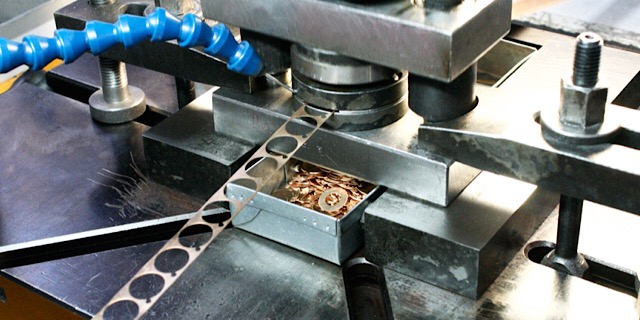Just How Metal Stamping Changes Production Performance
Just How Metal Stamping Changes Production Performance
Blog Article
Steel Marking Developments: Elevating Production Processes for Superior Results
In the world of producing procedures, steel stamping has long been a keystone method for creating a range of precision parts. With the ruthless march of technological advancement, the landscape of steel stamping is going through a substantial change.
Advancement of Metal Marking Strategies

Furthermore, advancements in material scientific research have led to the advancement of high-strength alloys that can now be effortlessly marked into elaborate shapes, satisfying a broader variety of commercial applications. The combination of robotics and fabricated intelligence has better optimized the stamping process by improving rate and precision while lowering the risk of human error.

Influence of Advanced Products
Have advanced materials changed metal marking processes considerably in the manufacturing market? By using materials such as high-strength alloys, progressed composites, and ingenious finishings, steel stamping procedures can currently generate components that are lighter, more powerful, and much more durable than ever before.
These sophisticated products provide premium mechanical residential or commercial properties, corrosion resistance, and thermal stability, allowing makers to satisfy the needs of contemporary markets such as aerospace, automotive, and electronics. Furthermore, making use of innovative products in metal stamping has facilitated the production of complicated geometries and complex layouts that were formerly unattainable via standard approaches.
Moreover, the application of sophisticated products has actually brought about lowered material waste, reduced production expenses, and shorter preparations, making metal stamping processes a lot more economical and sustainable. As innovation continues to advancement, the impact of advanced products on metal marking processes is anticipated to drive more advancement and improve the competition of manufacturers in the global market.
Automation in Steel Stamping
The evolution of metal marking procedures driven by the combination of innovative materials has actually established the stage for substantial developments in automation within the manufacturing sector. Automation in metal stamping has actually transformed production procedures, improving effectiveness, precision, and total output high quality. With the use of robotics, sensing units, and computer-controlled systems, tasks that were as soon as hand-operated and taxing can now be implemented with unparalleled rate and accuracy.
Automation in steel stamping not just accelerates production rates but also guarantees consistency in the production process. By minimizing human intervention, the risk of mistakes is substantially lowered, leading to greater reference levels of product uniformity and integrity. Furthermore, automation enables suppliers to carry out complex marking jobs that would be unwise or tough to accomplish by hand.
Furthermore, automation in metal stamping contributes to a safer working setting by minimizing the need for workers to participate in repetitive or harmful jobs - Metal Stamping. This change in the direction of automation not just boosts productivity yet likewise paves the method for the future of manufacturing, where innovation plays a main function in driving functional excellence
High Quality Control and Assessment Solutions
With a concentrate on accuracy and dependability, quality control and assessment systems play a critical function in guaranteeing product quality in metal marking processes. These systems are designed to monitor every phase of manufacturing, from product inspection to the end product, to assure that all parts meet the required requirements. By implementing innovative innovations such as optical evaluation systems, coordinate measuring equipments (CMM), and automated determining devices, suppliers can spot even the tiniest deviations in measurements, surface quality, and overall integrity of stamped parts.

Sustainability Practices in Metal Stamping
Building upon the foundation of precision and dependability developed with quality assurance and evaluation systems, the assimilation of lasting methods in steel marking processes is progressively ending up being a prime focus for makers seeking to minimize ecological influence and enhance resource utilization. Sustainability methods in metal marking incorporate click here for info a variety of initiatives focused on reducing waste generation, power intake, and greenhouse gas emissions throughout the manufacturing procedure.
One trick facet of sustainability in steel check my site marking is the fostering of green materials and technologies that promote recyclability and waste decrease. By utilizing recycled products and carrying out energy-efficient machinery, manufacturers can reduce their carbon footprint and contribute to a much more lasting production cycle. Furthermore, optimizing manufacturing processes to lessen product waste and power usage not just profits the environment yet likewise causes set you back savings for services over time.
In addition, the application of lasting practices in metal stamping can enhance brand reputation and attract environmentally conscious customers. As sustainability remains to acquire relevance in the production market, integrating green initiatives into steel stamping processes is important for long-lasting success and competitiveness in the market.
Conclusion
In verdict, metal stamping methods have substantially progressed over time, including advanced materials and automation to enhance producing processes. Quality assurance and evaluation systems play a crucial duty in ensuring superior results, while sustainability techniques are increasingly being executed to reduce ecological impact. These technologies in steel marking have reinvented the market, causing a lot more sustainable and effective manufacturing techniques for different industries.
Steel stamping, when a handbook and labor-intensive process, has actually transformed right into an extremely automated and sophisticated method of forming metal sheets into numerous forms and designs.Have advanced materials changed metal stamping procedures significantly in the production sector? By making use of materials such as high-strength alloys, progressed composites, and innovative finishes, steel stamping processes can now generate elements that are lighter, stronger, and extra durable than ever previously.
The development of metal marking processes driven by the assimilation of innovative products has actually set the phase for considerable developments in automation within the production industry.In conclusion, steel stamping methods have actually dramatically evolved over time, including innovative products and automation to boost producing procedures.
Report this page